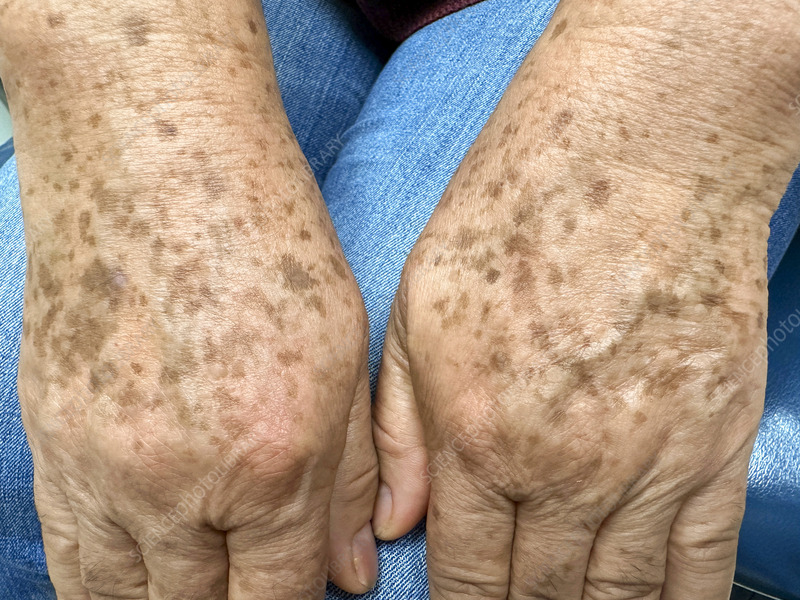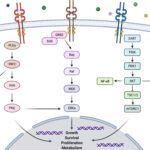Solar lentigines, commonly referred to as age spots, sun spots, or liver spots, are benign pigmented lesions that develop due to prolonged ultraviolet (UV) radiation exposure. These lesions are a hallmark of photoaging and typically affect individuals over the age of 40, particularly those with lighter skin types. Although harmless, their appearance often leads patients to seek dermatological evaluation and cosmetic treatment.

What Are Solar Lentigines?
Solar lentigines are sharply defined, flat brown, black, or grayish macules that arise in areas frequently exposed to the sun, including the face, hands, shoulders, chest, and upper back. Unlike freckles, they do not fade during winter and tend to increase in number and size with age and cumulative sun exposure.
Pathophysiology of Sun-Induced Pigmentation
Exposure to UV radiation—especially UVA and UVB rays—triggers melanocyte activity in the epidermis. The excess melanin produced gets deposited in the basal layer of the skin, leading to persistent hyperpigmented lesions. Over time, this localized melanocytic hyperplasia results in visible solar lentigines.
Risk Factors:
- Chronic sun exposure
- Use of tanning beds
- Fair skin (Fitzpatrick skin types I–III)
- Increasing age
- History of sunburns
- Immunosuppression
- Photosensitizing medications
Clinical Features and Diagnosis of Solar Lentigines
Key Characteristics:
| Feature | Description |
|---|---|
| Color | Light brown to dark brown |
| Shape | Round, oval, or irregular |
| Borders | Well-demarcated |
| Texture | Smooth and flat |
| Distribution | Sun-exposed areas |
Solar lentigines are usually asymptomatic but may cause cosmetic concern.
Differential Diagnosis:
- Lentigo maligna (premalignant)
- Seborrheic keratosis
- Melasma
- Ephelides (freckles)
- Pigmented actinic keratosis
Diagnostic Workflow
- Dermoscopy reveals a pigment network and fingerprint-like structures.
- Biopsy may be warranted if there is asymmetry, irregular borders, or rapid change—features suggestive of lentigo maligna.
Modern Treatment Options for Solar Lentigines
While not medically necessary, treatment is frequently pursued for aesthetic reasons. Management strategies range from topical agents to advanced laser therapies.
Topical Agents:
| Agent | Mechanism | Considerations |
|---|---|---|
| Hydroquinone | Melanin synthesis inhibitor | Effective but potential for irritation |
| Tretinoin | Epidermal turnover enhancer | Gradual fading, improves skin texture |
| Azelaic Acid | Tyrosinase inhibitor | Mild, suitable for sensitive skin |
| Kojic Acid | Chelates copper in tyrosinase | Often used in combination therapies |
Topical regimens often require 8–12 weeks for noticeable improvement and must be combined with strict sun protection.
Cryotherapy:
Liquid nitrogen is applied to the lesion to cause controlled destruction of melanocytes. Common side effects include hypopigmentation and blistering.
Chemical Peels:
- Agents such as trichloroacetic acid (TCA) and glycolic acid exfoliate pigmented skin layers.
- Best suited for lighter skin tones to avoid post-inflammatory hyperpigmentation.
Laser and Light-Based Therapies:
| Modality | Description | Pros |
|---|---|---|
| Q-switched Nd:YAG Laser | Targets melanin selectively | Effective with minimal downtime |
| Intense Pulsed Light (IPL) | Broad-spectrum light for diffuse pigmentation | Useful for large treatment areas |
| Fractional Lasers | Resurface skin while minimizing injury | Enhances texture and tone simultaneously |
Laser treatments yield faster and more dramatic results but require expertise to minimize risks such as scarring or pigment alteration.
Preventing the Formation of Solar Lentigines
Preventive strategies are critical to limit the development of new lesions and to maintain results post-treatment.
Sun Protection Essentials:
- Daily use of broad-spectrum sunscreen (SPF 30+)
- Wearing protective clothing and wide-brimmed hats
- Avoiding sun exposure between 10 AM and 4 PM
- Reapplication of sunscreen every 2 hours during outdoor activities
- Avoidance of artificial tanning devices
Prognosis and Long-Term Considerations
Solar lentigines are benign and carry no malignant potential. However, they serve as visible indicators of chronic sun damage, which is a major risk factor for actinic keratosis and non-melanoma skin cancers. Thus, their presence should prompt routine skin monitoring and sun safety education.
Frequently Asked Questions
Are solar lentigines cancerous?
No, solar lentigines are benign. However, similar-appearing lesions such as lentigo maligna require exclusion by a dermatologist.
Can solar lentigines fade naturally?
They rarely fade without intervention. Consistent sun protection may prevent further darkening but is unlikely to reverse existing spots.
Which treatment is best for dark skin tones?
Topical agents and low-energy laser settings should be used cautiously to avoid post-inflammatory hyperpigmentation.
How long do laser results last?
Laser results can last for years if combined with rigorous sun protection and maintenance skincare.
Can I use over-the-counter products?
Yes, many OTC formulations contain niacinamide, vitamin C, and alpha arbutin, which may help lighten pigmentation gradually.
Solar lentigines are a common, photo-induced dermatological condition reflecting cumulative UV exposure and aging. Although harmless, they frequently lead patients to seek dermatologic care due to aesthetic concerns. Through precise diagnosis and a wide range of treatment modalities—from topicals to laser therapy—solar lentigines can be effectively managed. Preventive strategies centered around sun protection are essential to avoid recurrence and maintain skin health.

